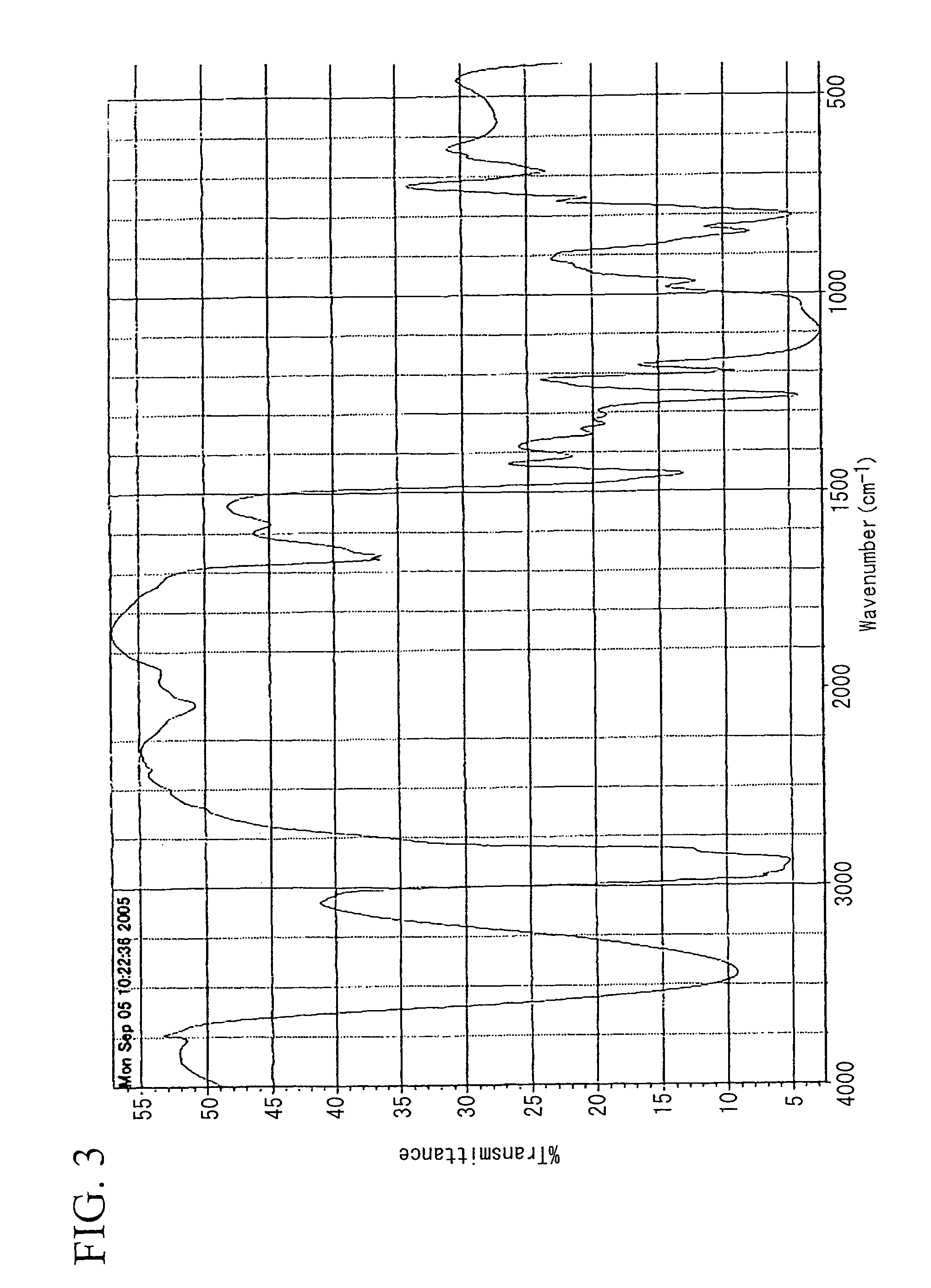Partially hydrocarbon group-blocked (poly)glycerol-modified polysiloxane, method for producing the same, and cosmetic composition containing the same
a polysiloxane, partially hydrocarbon group technology, applied in the direction of group 4/14 element organic compounds, chemical instruments and processes, organic chemistry, etc., can solve the problems of deterioration of the quality of the product per se or an aqueous solution thereof, inability to obtain a chemical structure estimated from a charging ratio, and increase reactivity, etc., to achieve superior operation properties, easy to blend in a cosmetic, and reduce viscosity
- Summary
- Abstract
- Description
- Claims
- Application Information
AI Technical Summary
Benefits of technology
Problems solved by technology
Method used
Image
Examples
example 1
[0109]Ethylene glycol monoallyl ether, in an amount of 1.88 g (18.4 mmol), and potassium t-butoxide, in an amount of 0.10 g (0.88 mmol), were mixed and the mixture was heated at 105° C. under a nitrogen atmosphere. A mixture of 10.9 g (147.2 mmol) of glycidol and 6.5 g (73.6 mmol) of glycidyl methyl ether purified in the aforementioned Reference Example was slowly added dropwise thereto over 3.5 hours (molar ratio of ethylene glycol monoallyl ether:glycidol:glycidyl methyl ether=1:8:4). After completion of the dropwise addition, the mixture was heated and stirred for 3 hours at 120° C. The mixture was cooled to room temperature, and 0.06 g of acetic acid was added thereto to stop the polymerization. Toluene in an amount of 10 g was added thereto, and KYOWADO 500 SN, which is a hydrotalcite-based absorbent manufactured by Kyowa Chemical Industry Co., Ltd., was added thereto, and the mixture was stirred for 2 hours. After the mixture was filtered, the materials with low boiling points...
examples 2 to 7
[0110]In the same manner as described in Example 1, a polymerization reaction was carried out with the composition shown in a table described below, and the corresponding one-terminal-allyloxyethoxy group-blocked partially-methylated polyglycerol was obtained. The results are shown in Table 1 and Table 2.
[0111]
TABLE 1ExampleExampleExampleExample2345Ethylene glycol1.881.881.881.88monoallyl ether (A) (g)Potassium t-butoxide (g)0.10.10.10.1Glycidyl methyl ether3.249.7212.9616.21(B) (g)Glycidol (C) (g)13.638.175.452.73Number average—*47011231328molecular weightDegree of dispersion—*1.7211.3781.388Molar ratio (A:B:C)1:2:101:6:61:8:41:10:2Molar ratio85:1554:4638:6223:77(OH group:CH3 group)*insoluble in chloroform
[0112]
TABLE 2ExampleExample67Ethylene glycol3.760.94monoallyl ether (A) (g)Potassium t-butoxide (g)0.10.1Glycidyl methyl ether12.9612.96(B) (g)Glycidol (C) (g)5.455.45Number average7531430molecular weightDegree of dispersion1.3971.445Molar ratio (A:B:C)1:4:21:16:8Molar ratio43:573...
example 8
[0113]Ethylene glycol monoallyl ether, in an amount of 1.88 g (18.4 mmol), and potassium t-butoxide, in an amount of 0.10 g (0.88 mmol), were mixed, and the mixture was heated at 120° C. under a nitrogen atmosphere. Glycidol, in an amount of 5.45 g (73.6 mmol), was slowly added dropwise thereto over 1.5 hours at 115 to 120° C. After completion of the dropwise addition, the mixture was heated and stirred for 2 hours at 120° C. to complete polymerization. Subsequently, 12.96 g (147.2 mmol) of glycidyl methyl ether purified in the aforementioned Reference Example was added thereto. Subsequently, the mixture was heated and stirred for 3 hours at 120 to 130° C. to complete block copolymerization (molar ratio of ethylene glycol monoallyl ether:glycidol:glycidyl methyl ether=1:4:8). The mixture was cooled to room temperature, and 0.06 g of acetic acid was added thereto, to stop the polymerization. Toluene in an amount of 10 g was added thereto, and KYOWADO 500 SN, which is a hydrotalcite-b...
PUM
| Property | Measurement | Unit |
|---|---|---|
| pH | aaaaa | aaaaa |
| temperature | aaaaa | aaaaa |
| particle size | aaaaa | aaaaa |
Abstract
Description
Claims
Application Information
 Login to View More
Login to View More - R&D
- Intellectual Property
- Life Sciences
- Materials
- Tech Scout
- Unparalleled Data Quality
- Higher Quality Content
- 60% Fewer Hallucinations
Browse by: Latest US Patents, China's latest patents, Technical Efficacy Thesaurus, Application Domain, Technology Topic, Popular Technical Reports.
© 2025 PatSnap. All rights reserved.Legal|Privacy policy|Modern Slavery Act Transparency Statement|Sitemap|About US| Contact US: help@patsnap.com



